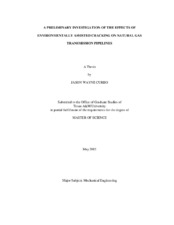| dc.contributor.advisor | Griffin, Richard B. | |
| dc.creator | Curbo, Jason Wayne | |
| dc.date.accessioned | 2005-08-29T14:39:39Z | |
| dc.date.available | 2005-08-29T14:39:39Z | |
| dc.date.created | 2005-05 | |
| dc.date.issued | 2005-08-29 | |
| dc.identifier.uri | https://hdl.handle.net/1969.1/2357 | |
| dc.description.abstract | Concepts for the development of a model to predict natural gas transmission
pipeline lifetime in a corrosive environment are constructed. Primarily, the effects of
environmentally assisted cracking (EAC) are explored. Tensile test specimens from a
sample of API 5L X-52 pipeline were tested in a simulated groundwater solution and
subsequently analyzed. The results suggested that the simulated environment ultimately
reduced the ductility of the test specimens; however, no evidence of ??classical?? stress
corrosion crack morphology was discovered. However, corrosion pits up to 0.75 mm
(0.03 in) were revealed during metallographic analysis. A Marin factor analogy and an
energy method concept are suggested and explored. Ultimately, the test data set was too
small for the results to be of any directly applicable significance. | en |
| dc.format.extent | 10531381 bytes | en |
| dc.format.medium | electronic | en |
| dc.format.mimetype | application/pdf | |
| dc.language.iso | en_US | |
| dc.publisher | Texas A&M University | |
| dc.subject | Mechanical Engineering | en |
| dc.subject | Corrosion | en |
| dc.title | A preliminary investigation of the effects of environmentally assisted cracking on natural gas transmission pipelines | en |
| dc.type | Thesis | en |
| thesis.degree.department | Mechanical Engineering | en |
| thesis.degree.discipline | Mechanical Engineering | en |
| thesis.degree.grantor | Texas A&M University | en |
| thesis.degree.name | Master of Science | en |
| thesis.degree.level | Masters | en |
| dc.contributor.committeeMember | Hogan, Harry A. | |
| dc.contributor.committeeMember | Trejo, David | |
| dc.type.genre | Electronic Thesis | en |
| dc.type.material | text | en |
| dc.format.digitalOrigin | born digital | en |


